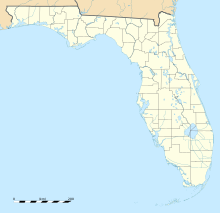Cross City Airport
Cross City Airport | |||||||||||||||
|---|---|---|---|---|---|---|---|---|---|---|---|---|---|---|---|
AMSL 42 ft / 13 m | | ||||||||||||||
| Coordinates | 29°38′08″N 083°06′17″W / 29.63556°N 83.10472°W | ||||||||||||||
| Map | |||||||||||||||
| Runways | |||||||||||||||
| |||||||||||||||
| Statistics (2018) | |||||||||||||||
| |||||||||||||||
Cross City Airport (IATA: CTY, ICAO: KCTY, FAA LID: CTY) is a county-owned, public-use airport located one nautical mile (2 km) east of the central business district of Cross City, a city in Dixie County, Florida, United States.[1] It is included in the National Plan of Integrated Airport Systems for 2011–2015, which categorized it as a general aviation facility.[2]
History
The airport was opened as a public airfield in April 1940. In August 1942, the facility was requisitioned by the
After the war, the airfield was returned to civil control. However, in the 1950s, the
Facilities and aircraft
Cross City Airport covers an area of 591
For the 12-month period ending April 5, 2018, the airport had 18,000 general aviation aircraft operations, an average of 49 per day. At that time there were 11 aircraft based at this airport: 7 single-engine, 1 multi-engine, 2 jet, and 1 helicopter.[1]
See also
References
- ^ PDF. Federal Aviation Administration. Effective August 10, 2023.
- ^ "2011–2015 NPIAS Report, Appendix A" (PDF). National Plan of Integrated Airport Systems. Federal Aviation Administration. October 4, 2010. Archived from the original (PDF, 2.03 MB) on September 27, 2012.
- ^ USAFHRA Document 00463594
External links
- Cross City Airport (PDF) from Continuing Florida Aviation System Planning Process (CFASPP)
- Aerial image as of February 1999 from USGS The National Map
- FAA Terminal Procedures for CTY, effective April 18, 2024
- Resources for this airport:
- FAA airport information for CTY
- AirNav airport information for KCTY
- ASN accident history for CTY
- FlightAware airport information and live flight tracker
- NOAA/NWS weather observations: current, past three days
- SkyVector aeronautical chart, Terminal Procedures


